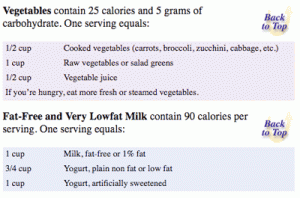The food exchange lists were developed in the 1950s by the American Dietetic Association, American Diabetes Association, and the U.S. Public Health Service in attempt to simplify the strict and complicated diabetic diet. The idea behind the exchange lists was to provide an educational tool to diabetics and to help provide structure in meal planning. The key to controlling diabetes is to control your blood sugar/blood glucose level. This system does a great job of outlining what you can do to help yourself to control your blood sugar.
A major downfall to this system is cracking down the complexity in order to implement it into your daily life. Therefore, it’s recommended for individuals to meet with a Registered Dietitian (a certified diabetes educator is ideal) in order to fully grasp this diet and help individualize it to your life and needs. The dietitian will recommend a certain number of daily exchanges from each food group based on your individual needs. You and the dietitian will work together to decide the best way to utilize the exchanges in order to control your blood sugar within your target range.
The Basics
- The word “exchange” in this context refers to the fact that a particular food in a certain list/category of food may be switched or interchanged with any other food item on the same list.
- Each list is a group of measured or weighed foods of approximately the same nutritional value.
- Foods are grouped into basic types — starches, fruits, milk, meat, vegetables, fats, etc.
- Within each group, you’ll see how much you can eat of various foods for the same amount of calories, carbohydrates and other nutrients.
- You can exchange/trade/substitute foods within a group because they’re similar in nutrient content and the manner in which they affect your blood sugar.
By controlling your blood sugar you help to prevent or delay the start of diabetes complications such as nerve, eye, kidney, and blood vessel damage. Implementing this exchange system can not only help with your blood sugar, but also be beneficial toward helping you manage your weight.
(Source: NHLBI.NIH.gov)


